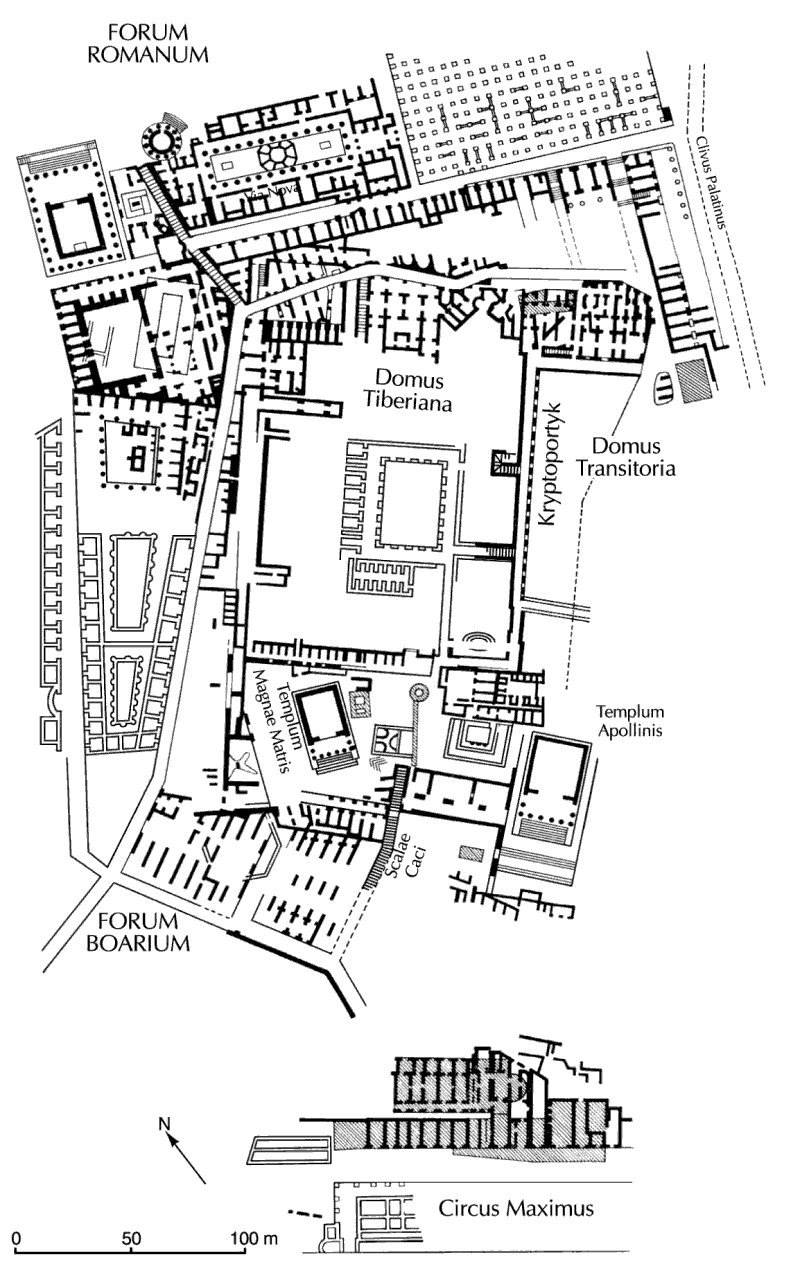Domus Transitoria: * a palace erected by Nero qua Palatium et Maecenatis hortos continuaverat (Tac. Ann. XV.39; cf. Suet. Nero 3: domum a Palatio Esquilias usque fecit quam primo transitoriam, mox incendio absumptam restitutamque auream nominavit). Its object was to connect with the Palatine, not merely the Horti Maecenatis (q.v.) but other estates (Horti Lamiani, Lolliani, etc.) which in one way or another had come into the possession of the imperial house. It was destroyed by the fire of 64 A.D. and replaced by the domus Aurea. No remains of it were believed to exist, until the excavations made by Boni under the southern portion of the state apartments of the domus Augustana (Flavia) led to the rediscovery of the remains of a sumptuous and beautifully decorated palace in two stories. By some it is attributed to the Domus Q. Lutatii Catuli (q.v.), but this will not agree with the date of the construction. Others assign it to Claudius, owing to the existence of a quarry mark bearing his name on a piece of cornice found there; but it is a good deal more likely that we have to deal with the remains of a part of the domus Transitoria (the attribution to the original house of Augustus (HJ 90) will not hold, as the remains are obviously of a later date); see Mem. Am. Acad. V.116, 121, 122.
To the lower floor belongs a sunk garden; one wall of it is occupied by a magnificent nymphaeum, once decorated with polychrome marbles, but terribly damaged in the excavations made by the Farnese in 1721 sqq. (Mitt. 1894, 22‑26; LR 163; PBS VII. p48, No. 100, where the references to Breval's Remarks should read Ser. I (1726) ii.298; Ser. II (1738) i.84 sqq.; Kirkhall's coloured engravings ó copies at Eton, Bn. 13, 51‑54). In the centre were two pavilions with p195small columns, and between them garden beds, with vertical walls of curved slabs of marble, as in the'Maison des JardiniŤres' at Timgad (Ill. 24). The wall opposite the nymphaeum is decorated with niches. On the south-west is a room with extremely beautiful paintings ó small scenes from the Homeric cycle, within a framework in which blue and gold are predominant. What little remains of the polychrome marble pavement and wall facing shows extreme delicacy and beauty (YW 1912, 10‑11; 1913, 22; BA 1914, Cr 73). The irregular curving concrete foundations which cut through the whole of this part of the building belong to the domus Aurea, as they are certainly posterior to the fire of Nero and equally certainly anterior to Domitian.
Two rooms to the north-east, wrongly known as the baths of Livia (HJ 90, n117), have been accessible since 1721; and their ceilings have been frequently drawn (PBS VII. p33, n24 (cf. Egger, Krit. Verzeichn. d. Handzeichn. in Wien, n114); ib. p. 60, n14, is there wrongly identified with the ceiling of the second room, which is, however, represented by Ronczewski, GewŲlbeschmuck, p29, fig. 16, and by Parker, photo 2227). Fine coloured drawings of both exist in the breakfast-room of the Soane Museum in Lincoln's Inn Fields in London.1
Beyond these rooms is a very large latrine, which has been wrongly thought to be the machinery chamber of a hydraulic lift, which would, it is supposed, have worked in a shaft over 120 feet deep found not far off (JRS 1913, 251). The dining-room with a revolving ceiling, which Boni supposed to have been worked by the same machinery, was in the domus Aurea (Suet. Nero, 31).
From each end of the nymphaeum a flight of marble stairs ascended to the upper floor. Under the later triclinium only the bed of the pavement is left; but to the south-west and north-east its white marble slabs can be seen, some three or four feet below the level of Domitian, who reconstructed this part of the palace with only one story, abolishing the lower floor entirely; while under his nymphaeum on the north-west may be seen a remarkably fine pavement of ēopus sectile, which when found showed clear and abundant traces of damage by fire. Close to it is a room which once contained a series of fountains, the water from which ran down to the nymphaeum below.
The piscina under the basilica of the Flavian palace is attributed to Nero by Boni (JRS 1913, 246), who wrongly refers Suet. cit. to the Palatine. See Domus Aurea, p166, and Domus Augustiana, p161. Cf. ZA 206‑208.
Other remains belonging to the domus Transitoria have been found near the junction of the Nova via with the clivus Palatinus (AJA 1923, 402); for remains under the platform of the temple of Venus and Rome, see LR 197, 198; Mitt. 1892, 289, 291; Mem. Am. Acad. V.121, 122. The palace, named Domus Transitoria, was an architectural masterpiece which stretched from the Palatine, where Nero first lived with his grand-uncle and adoptive father Claudius and his mother Agrippina, to the gardens of Maecenas on the Esquiline.
The residence was grandiose, but it did not last long. Built around 60 A.D., it was ruined in the Great Fire four years later and was replaced by the Domus Aurea, one of the most opulent palatial complexes ever constructed.
Platner and Asby 1929 LACUS CURTIUS
Joe Geranio
JCIA
D












